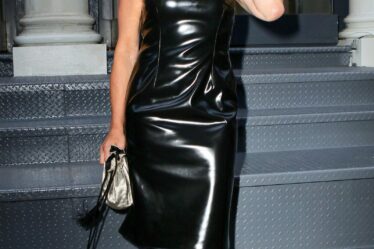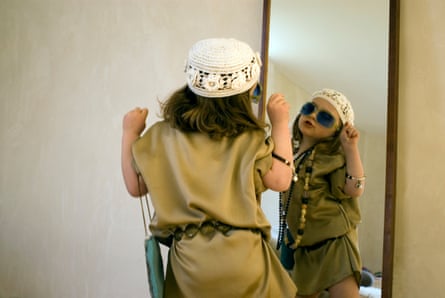
There is a corner of my wardrobe that I haven’t worn in years. It is made up of pieces that at one point in time (when I was younger and thinner) I loved to wear.
Flicking through them I can recall the late nights, important meetings, foreign cities, dates and dinners I’ve worn them to; I can’t bear the thought of selling them or giving them away. My hope is that when my niece grows up she will want to wear them (she’s two).
Although some minimalists insist your kids don’t want your old clothes, it’s actually common for my friends to lament their parents’ wardrobe cleanouts. I inherited some beautiful things from my mum and still deeply regret chopping a mid-length, floral silk dress she bought in Paris during her 20s into a minidress when indie-sleaze was cool the first time. Things with a sense of history, like that dress, or a coat of my grandfather’s I love to wear, hold a unique sense of power. Not to mention the way their quality outstrips almost anything available now.
At a time when garments have become alarmingly disposable (the average Australian buys 15kg of new textiles and sends 10kg to landfill, every year) – this week we meet four people who keep (and cherish) all their clothes.
The next-gen gifter: ‘There’s something special about items that can be passed down’
Tashi Graeme-Baker, a communications specialist, has a few reasons she holds on to certain items, but the biggest is a desire to pass on clothes to her children or close friends. “My mum has done that for me. I really appreciate that things I wear have been chosen by her at some point, enjoyed and then enjoyed again by me.”
Not all her archived pieces are reserved for future generations. “I have a lovely skirt and a few shirts that I have been wearing on and off for about 18 years. It’s nice pulling something out that you haven’t worn in a while – it’s like having something new, it always fits a little differently too.”
Keeping things also extends to her children’s wardrobes. She has a jumper her husband wore as a child, and a coat of her brother’s, that both her sons have used. “There’s something very special about items that can be passed down … having something good quality, or at least properly looked after, will stay with you for a long time.”
The collector: I might wear it in 10 years’ time
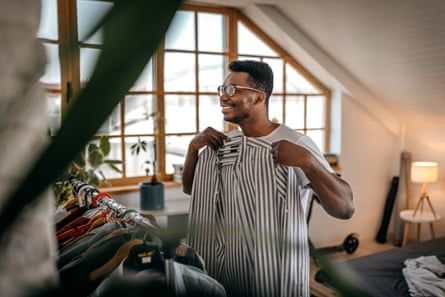
Jack Fordham, manager of vintage store the Vault, sees his wardrobe “as a collection, much like a collection of books”. He says that since trends circulate, “if I don’t wear it now, I might wear it in 10 years’ time”.
This way of thinking has been informed by years of working in the retail industry in fast and sustainable fashion. “I’ve been able to see the real value of a garment,” he says. Holding on to clothes “is both sentimental and economical for me”.
He also likes the dimension this adds to his wardrobe. Keeping bold pieces on hand allows him to “transform myself for that night”.
A tie-dye T-shirt he received as a present when he was 12 remains a favourite. “It was made in Costa Rica and was three sizes too big. I liked the shape of it then, and still now it has a great fit. It’s never lost its colour either.” Another is a suede jacket he bought in Barcelona. “It cost me €30 and has an incredible cropped fit with extra-long arms. I had to wear it back on the plane to be able to take it home, but it was worth it.”
The memory-keeper: ‘It brings me back to that exact day’
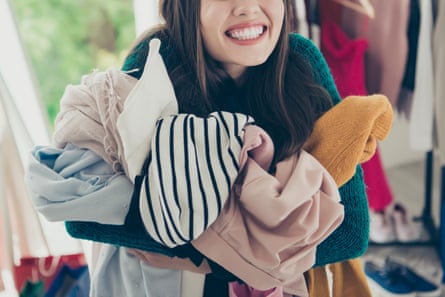
“Objects hold memories … items of clothing in particular, are like portals to distinct moments of my life,” says Anna Chiu, one half of the design duo behind Kamperett. “Like a cream-coloured knit blouse with wood beads that I wore when I got engaged on Catalina Island. I never wear it, yet when I hold it in my hands it brings me back to that exact day and I can’t let it go.”
Chiu values clothes that have a sense of history. In her own design process, she often draws on items inherited from her grandmother. “I love that her pieces are so timeless in design and are still in such great shape that they are able to be used well, in multiple lifetimes,” she says. “I have a blue striped cotton blouse and black winter coat with a faux fur collar that I wear all the time. She had great taste and always invested in quality over quantity.”
She keeps 90% of her wardrobe in her attic and admits to wearing the other 10% on repeat. “Some pieces I will reach for occasionally, and in those instances I am happy I still hung on to them.”
The valuer: ‘It needs to outlive the cost of its impact’
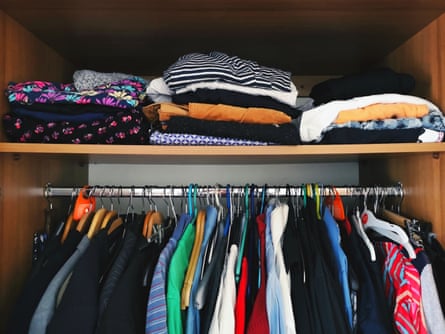
Fashion designer Jason Hewitt understands the inherent value of clothing. “I don’t believe in disposable anything,” he says. “It’s wasteful and places an unnecessary burden on the environment. There are costs in terms of energy and water consumption, shipping, human labour – all these small things that add up and go into every garment. So, when you buy something it needs to outlive the cost of its impact.”
This thinking has informed the way he’s curated his wardrobe over many years, with an emphasis on quality over quantity, including the suit he had tailor-made for his wedding, a vintage navy blue Perri Cutten coat, shirts passed down to him by his father and a suede coat that belonged to his grandfather.
“I pack away my winter stuff in tubs during summer to free up space,” he says. “Anything knitted is rolled. I use cedar balls in everything to keep away moths as they smell better than mothballs …. Delicate fabrics and things that can snag on other surfaces I keep in cloth bags.”

